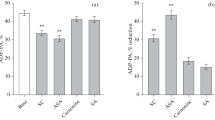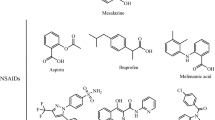Abstract
Purpose
The aim of this study was to create and assess biological activity of a new compound based on carnosine and acetylsalicylic acid (ASA) that will comprise antioxidant effect with antiplatelet activity, while simultaneously preventing side effects on the gastrointestinal tract.
Methods
Salicyl-carnosine (SC) was synthesized by condensation of ASA and carnosine. Antioxidant activity was determined by spectrophotometric and chemiluminescence methods. Antiplatelet activity was carried out by the light transmission-aggregometry method using the inductor ADP. Chronic gastric ulcer in rats was modeled using glacial acetic acid.
Results
Using SOD-like activity, iron-induced chemiluminescence, BaSO4-activated respiratory burst, and evaluation of red blood cell structure stabilization during oxidative damage induced by sodium hypochlorite, it was shown that SC possesses antioxidant activity analogous, or better, than that of carnosine. Antiplatelet activity of SC was evaluated in the blood of healthy individuals, and was also shown to be comparable to, or exceeding that of ASA. Also SC demonstrates high resistance to hydrolysis by tissue and serum carnosinases. Most importantly, it was shown that SC has protected the gastric mucosa against the formation of stomach ulcerative lesions and promoted their epithelization, therefore overcoming the undesirable inherent side effects of ASA.
Conclusions
SC preserves pharmacologically significant properties of ASA and carnosine while retaining an anti-ulcer activity and resistance to the carnosinase hydrolysis at the same time. These properties are particularly promising for the potential development of new anti-inflammatory and antithrombotic drugs.

.






Similar content being viewed by others
Abbreviations
- ASA:
-
acetylsalicylic acid
- CL:
-
chemiluminescence
- COX:
-
cyclooxygenase
- HPLC:
-
high performance liquid chromatography
- HRMS:
-
high resolution mass spectrometry
- LP:
-
lipoproteins
- LPO:
-
lipid peroxidation
- NBT:
-
nitroblue tetrazolium
- NSAIDs:
-
non-steroidal anti-inflammatory drugs
- ROS:
-
reactive oxygen species
- SA:
-
Salicylic acid
- SC:
-
salicyl-carnosine
- SOD:
-
Cu/Zn-superoxide dismutase
- TEA:
-
trimethylamine
- TLC:
-
thin layer chromatography
- TCA:
-
trichloroacetic acid
- STC:
-
Trolox-L-carnosine
- RTC:
-
(R)-Trolox-L-carnosine
References
Vlot AC, Dempsey DA, Klessig DF. Salicylic acid, a multifaceted hormone to combat disease. Annu Rev Phytopathol. 2009;47:177–206. https://doi.org/10.1146/annurev.phyto.050908.135202.
Vane J. Inhibition of prostaglandin synthesis as a mechanism of action for aspirin-like drugs. Nat New Biol. 1971;231:232–5.
Awtry EH, Loscalzo J. Aspirin. Circulation. 2000;101:1206–18. https://doi.org/10.1161/01.CIR.101.10.1206.
Ekinci D. Salicylic acid derivatives: synthesis, features and usage as therapeutic tools. Expert Opin Ther Pat. 2011;21:1831–41. https://doi.org/10.1517/13543776.2011.636354.
Mekaj YH, Daci FT, Mekaj AY. New insights into the mechanisms of action of aspirin and its use in the prevention and treatment of arterial and venous thromboembolism. Ther Clin Risk Manag. 2015;11:1449–56. https://doi.org/10.2147/TCRM.S92222.
Domashenko MA, Maksimova MY, Tanashyan MM. Acetylsalicylic acid in the treatment and prevention of cerebrovascular diseases. RMJ Neurol Psychiatry. 2011;30:1930–6 Russian.
Mitchell AG, Broadhead JF. Hydrolysis of solubilized aspirin. J Pharm Sci. 1967;56:1261–6.
Rowland PM, Riegelman S, Harris PA, Sholkoff SD, Eyring EJ. Kinetics of acetylsalicylic acid disposition in man. Nature. 1967;215:413–4.
Tanashyan MM, Domashenko MA, Raskurazhev AA. Aspirin resistance: clinical and molecular genetic evaluation techniques. Annals Clin Exp Neurol. 2016;10:41–6 Russian.
Shi X, Ding M, Dong Z, Chen F, Ye J, Wang S, et al. Antioxidant properties of aspirin: characterization of the ability of aspirin to inhibit silica-induced lipid peroxidation, DNA damage, NF-kappaB activation, and TNF-alpha production. Mol Cell Biochem. 1999;199:93–102.
Aruoma OI, Halliwell B. The iron-binding and hydroxyl radical scavenging action of anti-inflammatory drugs. Xenobiotica. 1988;18:459–70. https://doi.org/10.3109/00498258809041682.
Baltazar MT, Dinis-Oliveira RJ, Duarte JA, Bastos ML, Carvalho F. Antioxidant properties and associated mechanisms of salicylates. Curr Med Chem. 2011;18:3252–64. https://doi.org/10.2174/092986711796391552.
Berezhnoy DS, Stvolinsky SL, Lopachev AV, Devyatov AA, Lopacheva OM, Kulikova OI, et al. Carnosine as an effective neuroprotector in brain pathology and potential neuromodulator in normal conditions. Amino Acids. 2019;51(1):139–50. https://doi.org/10.1007/s00726-018-2667-7.
Boldyrev AA, Aldini G, Derave W. Physiology and pathophysiology of Carnosine. Physiol Rev. 2013;93:1803–45. https://doi.org/10.1152/physrev.00039.2012.
Trubitsina IE, Shabanova ME, Chikunova BZ, Shavratsky VK, Formazyuk VB, Sergienko VI, et al. Characteristics of antiulcer activity of carnosine. Patol Fiziol Eksp Ter. 1997;4:17–20 Russian.
Wolos A, Piekarska K. Carnosinase in the kidney and liver. Int J Biochem. 1975;6:723–6.
Stvolinsky SL, Antonova NA, Kulikova OI, Lopachev AV, Abaimov DA, Al-Baidani I, et al. Lipoilcarnosine: synthesis, study of physico-chemical and antioxidant properties, biological activity. Biomed Khim. 2018;64(3):268–75. https://doi.org/10.18097/PBMC20186403268 Russian.
Stvolinsky SL, Bulygina ER, Fedorova TN, Meguro K, Sato T, Tyulina OV, et al. Biological activity of novel synthetic derivatives of carnosine. Cell Mol Neurobiol. 2010;30(3):395–404. https://doi.org/10.1007/s10571-009-9462-7.
Dubois VD, Bastawrous A. N-acetylcarnosine (NAC) drops for age-related cataract. Cochrane Database Syst Rev. 2017;28;2:CD009493. https://doi.org/10.1002/14651858.CD009493.pub2.
Tanashyan MM, Fedorova TN, Stvolinskij SL, Andreeva LA, Nagaev IY, Migulin VA, Shabalina AA, Trubitsyna IE, Lopachev AV, Kulikova OI, Abaimov DA. Agent possessing antiaggregant, cytoprotective and antioxidant activity. RU 2694061 C1.
Gulyaeva NV. Superoxide-scavenging activity of carnosine in the presence of copper and zinc ions. Biokhimiia. 1987;52(7):1216–20.
Fedorova TN, Us KS, Ostrovskaya RU. Estimation of the antioxidant effect of the Nootropic dipeptide Noopept on the model of Fe2+-induced Chemiluminescence of lipoproteins of human serum in vitro. Neurochem J. 2007;1:260–3.
Vladimirov YA. Studies of the antioxidant activity by measuring chemiluminescence kinetics. in Proceedings of the International Symposium on Natural Antioxidants: Molecular Mechanism and Health Effects / Ed. Packer L., Traber M.G., Xin W. AOCS Press: Champaing., Illinois, 1996:125–144.
Pegova A, Abe H, Boldyrev A. Hydrolysis of carnosine and related compounds by mammalian carnosinases. Comp Biochem Physiol. Part B. Biochem Mol Biol. 2000;127:443–6.
Boldyrev A, Abe H, Stvolinsky S, Tyulina O. Effects of carnosine and related compounds on generation of free oxygen species: a comparative study. Comp Biochem Physiol B Biochem Mol Biol. 1995;112(3):481–5.
Prokopieva VD, Bohan NA, Johnson P, Abe H, Boldyrev AA. Effects of carnosine and related compounds on the stability and morphology of erythrocytes from alcoholics. Alcohol Alcohol. 2000;35:44–8.
Tanashyan MM, Spavronskaya LR, Shabalina AA, Abaimov DA, Raskurazhev AA. Platelet aggregation characteristics and pharmacokinetics of salicylic and acetylsalicylic acids in patients with cerebrovascular disorders. Eksp Klin Farmakol. 2017;80:48–51.
Born GVR. Aggregation of blood platelets by adenosine diphosphate and its reversal. Nature. 1961;194:927–9.
Okabe S, Roth JL, Pfeiffer CJ. A method for experimental, penetrating gastric and duodenal ulcers in rats. Observations on normal healing. Am J Dig Dis. 1971;16:277–84.
Cao G, Alessio HM, Cutler RG. Oxygen-radical absorbance capacity assay for antioxidants. Free Radic Biol Med. 1993;14(3):303–11.
Fee JA, Peisach J, Mims WB. Superoxide dismutase. Examination of the metal binding sites by electron spin echo spectroscopy. J Biol Chem. 1981;25;256(4):1910–4.
Kataoka M, Tonooka K, Ando T, Imai K, Aimoto T. Hydroxyl radical scavenging activity of nonsteroidal anti-inflammatory drugs. Free Radic Res. 1997;27(4):419–27.
Durak I, Karaayvaz M, Cimen MY, Avci A, Cimen OB, Büyükkoçak S, et al. Aspirin impairs antioxidant system and causes peroxidation in human erythrocytes and Guinea pig myocardial tissue. Hum Exp Toxicol. 2001;20(1):34–7.
Kohen R, Misgav R, Ginsburg I. The SOD like activity of copper:carnosine, copper:anserine and copper:homocarnosine complexes. Free Radic Res Commun. 1991;12–13 Pt 1:179–85.
Joshi R, Kumar S, Unnikrishnan M, Mukherjee T. Free radical scavenging reactions of sulfasalazine, 5-aminosalicylic acid and sulfapyridine: mechanistic aspects and antioxidant activity. Free Radic Res. 2005;39(11):1163–72.
Couto D, Ribeiro D, Freitas M, Gomes A, Lima JL, Fernandes E. Scavenging of reactive oxygen and nitrogen species by the prodrug sulfasalazine and its metabolites 5-aminosalicylic acid and sulfapyridine. Redox Rep. 2010;15(6):259–67. https://doi.org/10.1179/135100010X12826446921707.
Badwey JA, Karnovsky ML. Active oxygen species and the functions of phagocytic leukocytes. Annu Rev Biochem. 1980;49:695–726.
Black HS. Role of reactive oxygen species in inflammatory process. In: Hensbyand C., Lowe NJ, editors. Non-steroidal Anti-inflammatory Drugs: Pharmacology and the Skin. Basel: Karger;1989. Vol. 2, p. 1–20.
Pattison DI and Davies MJ. Evidence for rapid inter- and intramolecular chlorine transfer reactions of histamine and carnosine chloramines: Implications for the prevention of hypochlorous acid-mediated damage. Biochemistry. 2006;4;45(26):8152–8162.
Benbarek H, Ayad A, Deby-Dupont G, Boukraa L, Serteyn D. Modulatory effects of non-steroidal anti-inflammatory drugs on the luminol and lucigenin amplified chemiluminescence of equine neutrophils. Vet Res Commun. 2012;36(1):29–33.
Stvolinsky SL, Sousa Pontesh E, Sergienko VI. Boldyrev AA Immunomodulatory effects of carnosine in vitro and in vivo. Biol Membr. 1996;13(3):299–306 Russian.
Fedorova TN, Belyaev MS, Trunova OA, Gnezditsky VV, Maximova MY, Boldyrev AA. Neuropeptide carnosine increases stability of lipoproteins and red blood cells as well as efficiency of immune competent system in patients with chronic discirculatory encephalopathy. Biochem (Moscow) Suppl Ser A. 2009;3:62–5. https://doi.org/10.1134/S1990747809010085.
Yeung J, Li W, Holinstat M. Platelet signaling and disease: targeted therapy for thrombosis and other related diseases. Pharmacol Rev. 2018;70(3):526–48. https://doi.org/10.1124/pr.117.014530.
Nikitenko NI, Shavratskiĭ VK, Boldyrev AA, Suslina ZA, Ionova VG. Effect of carnosine and its derivatives on ADP-induced human platelet aggregation. Biomed Khim. 1995;41(1):41–3 Russian.
Ukawa H, Yamakuni H, Kato S, Takeuchi K. Effects of cyclooxygenase-2 selective and nitric oxide-releasing nonsteroidal anti-inflammatory drugs on mucosal ulcerogenic and healing responses of the stomach. Dig Dis Sci. 1998;43:2003–11.
Zhen XE, Zong M, Gao SN, Cao YG, Jiang L, Chen SX, Wang K, Sun SQ, Peng HS, Bai YH, Li S. Preparation and characterization of a novel aspirin derivative with anti-thrombotic and gastric mucosal protection properties. PLoS One. 2014;3;9(6):e98513. doi: https://doi.org/10.1371/journal.pone.0098513.
Naito Y, Yoshikawa T, Yagi N, et al. Effects of polaprezinc on lipid peroxidation, neutrophil accumulation, and TNF-alpha expression in rats with aspirin-induced gastric mucosal injury. Dig Dis Sci. 2001;46(4):845–51.
Yoshikawa T, Naito Y, Tanigawa T, Yoneta T, Yasuda M, Ueda S, et al. Effect of zinc-carnosine chelate compound (Z-103), a novel antioxidant, on acute gastric mucosal injury induced by ischemia-reperfusion in rats. Free Radic Res Commun. 1991;14(4):289–96.
Ueda K, Ueyama T, Oka M, et al. Polaprezinc (zinc L-carnosine) is a potent inducer of anti-oxidative stress enzyme, heme oxygenase (HO)-1—a new mechanism of gastric mucosal protection. J Pharmacol Sci. 2009;110(3):285–94. https://doi.org/10.1254/jphs.09056fp.
Zhang Q, Feng L. Protective effect of polaprezinc on acute gastric mucosal injury in rats. Zhong Nan Da Xue Xue Bao Yi Xue Ban. 2019;28;44(1):22–27. https://doi.org/10.11817/j.issn.1672-7347.2019.01.004.
Acknowledgments
This work was supported by state assignment of Research Center of Neurology.
Author information
Authors and Affiliations
Corresponding author
Ethics declarations
Conflict of interest
The authors declare no conflict of interest.
Additional information
Publisher’s note
Springer Nature remains neutral with regard to jurisdictional claims in published maps and institutional affiliations.
Electronic supplementary material
ESM 1
(DOCX 1199 kb)
Rights and permissions
About this article
Cite this article
Kulikova, O.I., Stvolinsky, S.L., Migulin, V.A. et al. A new derivative of acetylsalicylic acid and carnosine: synthesis, physical and chemical properties, biological activity. DARU J Pharm Sci 28, 119–130 (2020). https://doi.org/10.1007/s40199-019-00323-x
Received:
Accepted:
Published:
Issue Date:
DOI: https://doi.org/10.1007/s40199-019-00323-x




